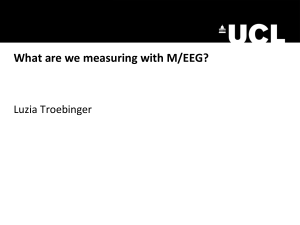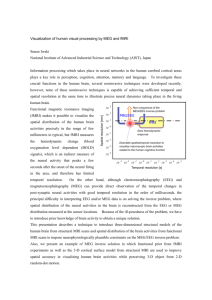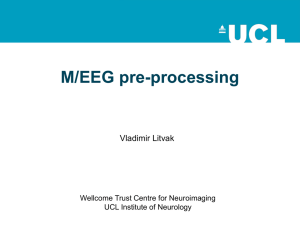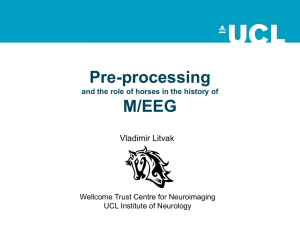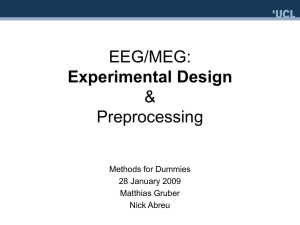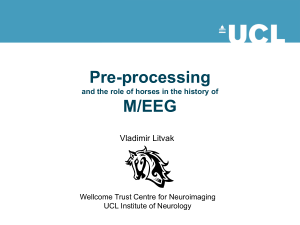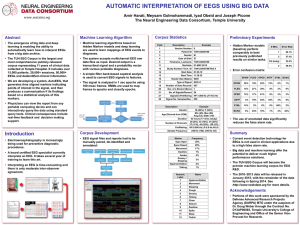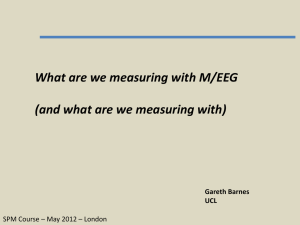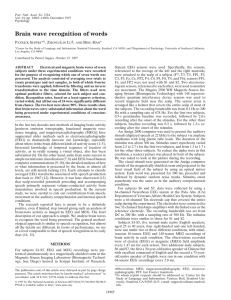M/EEG: Statistical analysis and source localisation
advertisement
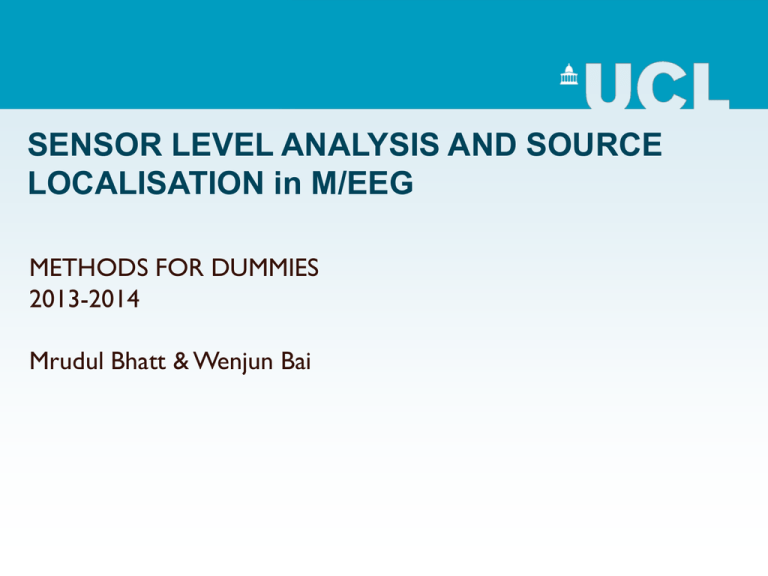
SENSOR LEVEL ANALYSIS AND SOURCE LOCALISATION in M/EEG METHODS FOR DUMMIES 2013-2014 Mrudul Bhatt & Wenjun Bai M/EEG SO FAR Source of Signal Dipoles Preprocessing and Experimental design Statistical Analysis Source Reconstruction 3 Statistical Analysis 1. Sensor level analysis in SPM 2. Scalp vs. Time Images 3. Time-frequency analysis Data is time varying modulation of EEG/MEG signal amplitude (or frequency specific power) at each electrode or sensor. Interested in statistical significance of condition specific effects (observed at some peri-stimulus time or at a particular sensor) at sensors Need to control FWER - the probability of making a false positive over the whole search space - AKA multiple comparisons problem FWER scales with number of observations Bonferroni too conservative due to assumption of independence between neighbouring samples Can circumvent issue if space/time of interest is specified a priori Average data over pre-specified sensors or time bins of interest - produces one summary statistic per subject per condition If this is not possible can use topological inference Topological inference • Based on RFT • RFT provides a way of adjusting p-values for the fact that neighbouring sensors are not independent due to continuity in the original data • Provided data is smooth, RFT correction is more sensitive than a bonferroni correction • This is the method used in SPM Steps in SPM Data transformed to image files (NifTI) Procedurally identical to 1st level analysis in PET or 2nd level in fMRI after this Analysis assumes one summary statistic image per subject per condition Creating Summary Statistics: Conversion to images • Data converted to an image by generating a scalp map for each time frame and stacking over peristimulus time • Scalp maps are generated from using the 2D sensor layout (specified in data set) and linear interpolation between sensors (64 pixels each spatial direction suggested) • 3D image files (space x space x time) • If time-window of interest is known in advance we can average over this are and create a 2D spatial image 9 Time-Frequency Data • In principle can apply topological inference for n dimensions • In SPM 8 its limited to 3 dimensions • If data has time-frequency components it must be reduced from 4D (space x space x time x frequency) to 3/2D • Reduce data by averaging over frequency (3D) or spatial channels (2D time-frequency image) • When averaging over frequency, bandwidth must be specified and a new data set is produced and is exported in the same way images in the time domain are 11 Smoothing Smoothing: prior to 2nd level/group analysis -multi dimensional convolution with Gaussian kernel. Important to accommodate spatial/temporal variability over subjects and ensure images conform to assumptions. Multi-dimensional convolution with Gaussian kernel EEG analysis steps Epoching D/A conversion Digital filtering Baseline correction Artifact reduction Single trial averaging Re-referencing Grand averaging Plotting, spline and CSD maps Quantification Statistical evaluation 13 EEG/MEG source localization •The purpose of source localization •The hurdle prevent us to accurately localize the source : Inverse Problem A little recap: The advantage of EEG compare to fMRI: Superior Temporal resolution, with the cost of inferior spatial resolution 14 Why it is so challenging? Smearing and distortion 15 Inverse Problem Forward problem (well-posed) Data Y Inverse problem (ill-posed) Current density J 16 Analogy to understand the inverse problem How We Deal with Inverse Problem 1.Setting up Assumptions(Constraints) 2.Two Basic Approaches A. Discrete Source Analysis B. Distributed Source Analysis Anatomical constraints Final Product: Reconstructed Source ill-posed inverse problem EEG/MEG Data Functional constraints 18 Constraints Assumptions about the nature of the sources Three Types of Constraints: 1. Mathematic Constraints( e.g., minimum norm, maximum smoothness, optimal resolution, temporal independence) 2. Anatomical Constraints (e.g., Normally use the subject’s MRI scan, if not, it is possible to use standardized MRI brain atlas (e.g., MNI) can be be warped to optimally fit the subject's anatomy based on the subject's digitized head shape.) 3. Functional Constraints (e.g., 19 Discrete vs. Distributed Source Model Discrete source analysis Distributed source analysis Current dipole represents an extended brain area Each current dipole represents one small brain segment Number of sources < number of sensors Number of sources > number of sensors The leadfieldmatrix has more rows (number of sensors) than colums (number of sources) The leadfieldmatrix has more colums than rows Result: Source model and source waveforms Result: 3D Volume image for each time point 20 Algorithms associated with each analysis Discrete source analysis Distributed source analysis 1. Parametric Dipole source fitting: (a)Uncorrelated noise model (b)Correlated noise model (c) Global minimization 1.Spatial scanning and beamforming: independently scan for dipoles within a grid containing candidate locations (i.e., source points) All (a)(b)(c) algorithms converges to a local minima in the multidimensional space of parameters, the optimal parameters (each corresponding to a dimension) are found. The algorithms estimates five nonlinear parameters per dipole: the x, y, and z dipole position values, and the two angles necessary to define dipole orientations in 3D space. 2. Distributed MAP- based estimation assume dipoles at all possible candidate locations of interest within a grid and/or mesh called the sourcespace (e.g., source-points in grey matter) and then solve the underdetermined linear system of equations Take Home Message 1: No cure-it-all Approach 21 SPM Pipeline for source localization One kind reminder: Source Localization(source reconstruction) is a computationally intense procedure. If you get “out of Memory” error message, try more powerful computer 22 Step 1: Mesh MRI – individual head meshes (boundaries of different head compartments) based on the subject’s structural scan template MRI Template – SPM’s template head model based on the MNI brain Step 2: Coregister Co-register Step 3: Forward Model Step 4: Invert (The most crucial) WHAT DO WE GET Comparison between fMRI and MEG on Temporal Resolution Take Home Message 2: Source Localization is not perfect, being cautious in drawing any inferences related to location and strengthen of the source REFERENCES Tolga Esat Ozkurt-High Temporal Resolution brain Imaging with EEG/MEG Lecture 10: Statistics for M/EEG data James Kilner and Karl Friston. 2010.Topological Inference for EEG and MEG. Annals of Applied Statistics Vol 4:3 pp 1272-1290 Vladimir Litvak et al. 2011. EEG and MEG data analysis in SPM 8. Computational Intelligence and Neuroscience Vol 2011 MFD 2012/13 31
